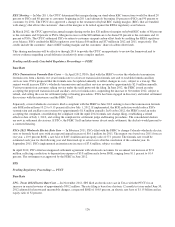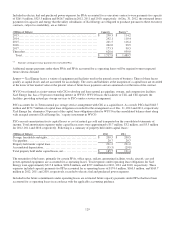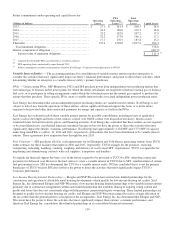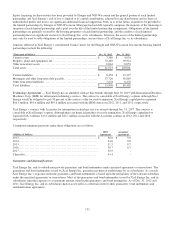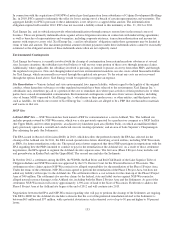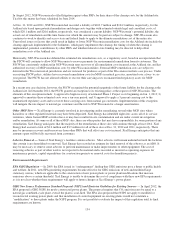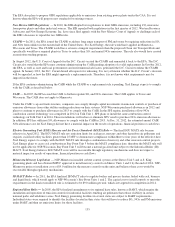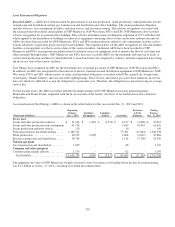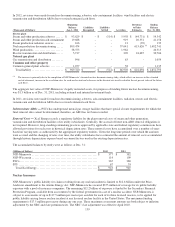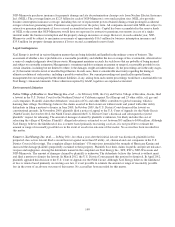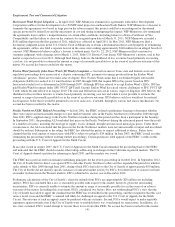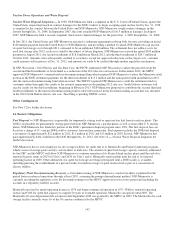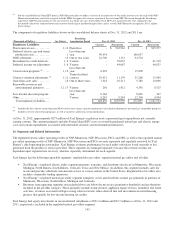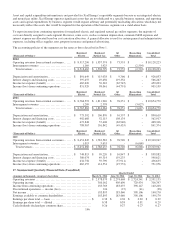Xcel Energy 2012 Annual Report Download - page 146
Download and view the complete annual report
Please find page 146 of the 2012 Xcel Energy annual report below. You can navigate through the pages in the report by either clicking on the pages listed below, or by using the keyword search tool below to find specific information within the annual report.
136
PSCo
In 2011, the Colorado Air Quality Control Commission (CAQCC) approved a BART SIP incorporating the Colorado CACJA
emission reduction plan, which will satisfy regional haze requirements. The Colorado legislature enacted a statute approving the
SIP (the Colorado SIP), which was signed into law in 2011. Subsequently, the Colorado Mining Association (CMA) challenged
the Colorado SIP in a Colorado District Court. In June 2012, the CMA’s appeal was dismissed. The CMA appealed this decision
to the Colorado Court of Appeals The CMA has requested that the Colorado Supreme Court hear the case directly, bypassing the
Court of Appeals. The Supreme Court has not yet made a decision on the CMA’s petition.
In September 2012, the EPA granted final approval of the Colorado SIP, including the CACJA emission reduction plan for PSCo,
as satisfying BART requirements. The emission controls are expected to be installed between 2014 and 2017. Projected costs for
emission controls at the Hayden and Pawnee plants are $334.2 million. PSCo expects the cost of any required capital investment
will be recoverable from customers.
In 2010, two environmental groups petitioned the DOI to certify that 12 coal-fired boilers and one coal-fired cement kiln in
Colorado are contributing to visibility problems in Rocky Mountain National Park. The following PSCo plants are named in the
petition: Cherokee, Hayden, Pawnee and Valmont. The groups allege that the Colorado BART rule is inadequate to satisfy the
CAA mandate of ensuring reasonable further progress towards restoring natural visibility conditions in the park. It is not known
when the DOI will rule on the petition.
NSP-Minnesota
In 2009, the MPCA approved the SIP for Minnesota (the Minnesota SIP), and submitted it to the EPA for approval. The MPCA
selected the BART controls for Sherco Units 1 and 2 to improve visibility in the national parks. The MPCA concluded SCRs
should not be required because the minor visibility benefits derived from SCRs do not outweigh the substantial costs. The
MPCA’s source-specific BART controls for Sherco Units 1 and 2 consist of combustion controls for NOx and scrubber upgrades
for SO2. The combustion controls have been installed on Sherco Units 1 and 2. The scrubber upgrades are underway and
scheduled to be completed by January 2015.
The EPA’s preliminary review of the Minnesota SIP in 2011 indicated that SCR controls should be added to Sherco Units 1 and
2. Subsequently, the EPA and MPCA both determined that CSAPR meets BART requirements for purposes of the Minnesota SIP.
In addition, the MPCA retained its source-specific BART determination for Sherco Units 1 and 2 from the 2009 Minnesota SIP.
The EPA approved the Minnesota SIP for EGUs, and also approved the source-specific emission limits for Sherco Units 1 and 2
as strengthening the Minnesota SIP, but avoided characterizing them as BART limits.
In August 2012, the National Parks Conservation Association, Sierra Club, Voyageurs National Park Association, Friends of the
Boundary Waters Wilderness, Minnesota Center for Environmental Advocacy and Fresh Energy appealed the EPA’s approval of
the Minnesota SIP to the U.S. Court of Appeals for the Eight Circuit. The Court denied intervention in the case to NSP-Minnesota
and other regulated parties who petitioned to intervene. It is not yet known how the D.C. Circuit’s reversal of the CSAPR may
impact the EPA’s approval of the Minnesota SIP.
The estimated cost for meeting the BART, regional haze and other CAA requirements is approximately $50 million, of which $31
million has already been spent on projects to reduce NOx emissions on Sherco Units 1 and 2. Xcel Energy anticipates that all
costs associated with BART compliance will be fully recoverable through regulatory recovery mechanisms. If the above litigation
results in further EPA proceedings concerning the Minnesota SIP, such proceedings may consider whether SCRs should be
required for Sherco Units 1 and 2.
In addition to the regional haze rules, there are other visibility rules related to a program called the Reasonably Attributable
Visibility Impairment (RAVI) program. In 2009, the DOI certified that a portion of the visibility impairment in Voyageurs and
Isle Royale National Parks is reasonably attributable to emissions from NSP-Minnesota’s Sherco Units 1 and 2. The EPA is
required to make its own determination as to whether Sherco Units 1 and 2 cause or contribute to RAVI and, if so, whether the
level of controls required by the MPCA is appropriate. The EPA plans to issue a separate notice on the issue of BART for Sherco
Units 1 and 2 under the RAVI program. It is not yet known when the EPA will publish a proposal under RAVI or what that
proposal will entail. In December 2012, a lawsuit against the EPA was filed in the U.S. District Court for the District of
Minnesota by the following organizations: National Parks Conservation Association, Minnesota Center for Environmental
Advocacy, Friends of the Boundary Waters Wilderness, Voyageurs National Park Association, Fresh Energy and Sierra Club. The
lawsuit alleges that the EPA has failed to perform a nondiscretionary duty to determine BART for the Sherco Units 1 and 2 under
the RAVI program. The EPA filed an answer denying the allegations and asserting that it did not have a nondiscretionary duty
under the RAVI program. NSP-Minnesota has asked the Court to allow it to intervene in this litigation. The Court is expected to
rule on NSP-Minnesota’s request by mid-March 2013.


